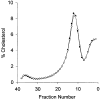Levels of lipoprotein(a), apolipoprotein B, and lipoprotein cholesterol distribution in IDDM. Results from follow-up in the Diabetes Control and Complications Trial
- PMID: 7556961
- PMCID: PMC2866034
- DOI: 10.2337/diab.44.10.1218
Levels of lipoprotein(a), apolipoprotein B, and lipoprotein cholesterol distribution in IDDM. Results from follow-up in the Diabetes Control and Complications Trial
Abstract
Levels of lipoprotein(a) [Lp(a)], apolipoprotein (apo) B, and lipoprotein cholesterol distribution using density-gradient ultracentrifugation were measured as part of a cross-sectional study at the final follow-up examination (mean 6.2 years) in the Diabetes Control and Complications Trial. Compared with the subjects in the conventionally treated group (n = 680), those subjects receiving intensive diabetes therapy (n = 667) had a lower level of Lp(a) (Caucasian subjects only, median 10.7 vs 12.5 mg/dl, respectively; P = 0.03), lower apo B (mean 83 vs. 86 mg/dl, respectively; P = 0.01), and a more favorable distribution of cholesterol in the lipoprotein fractions as measured by density-gradient ultracentrifugation with less cholesterol in the very-low-density lipoprotein and the dense low-density lipoprotein fractions and greater cholesterol content of the more buoyant low-density lipoprotein. Compared with a nondiabetic Caucasian control group (n = 2,158), Lp(a) levels were not different in the intensive treatment group (median 9.6 vs. 10.7 mg/dl, respectively; NS) and higher in the conventional treatment group (9.6 vs. 12.5 mg/dl, respectively; P < 0.01). No effect of renal dysfunction as measured by increasing albuminuria or reduced creatinine clearance on Lp(a) levels could be demonstrated in the diabetic subjects. Prospective follow-up of these subjects will determine whether these favorable lipoprotein differences in the intensive treatment group persist and whether they influence the onset of atherosclerosis in insulin-dependent diabetes.
Figures








Similar articles
-
Association between lipoprotein(a) and insulin-like growth factor I during puberty and the relationship to microalbuminuria in children and adolescents with IDDM.Diabetes Care. 1995 Jul;18(7):933-9. doi: 10.2337/diacare.18.7.933. Diabetes Care. 1995. PMID: 7555552
-
Serum lipids and lipoprotein(a) concentrations in Chinese NIDDM patients. Relation to metabolic control.Diabetes Care. 1995 Aug;18(8):1191-4. doi: 10.2337/diacare.18.8.1191. Diabetes Care. 1995. PMID: 7587858
-
Response of apolipoprotein AIV and lipoproteins to glycaemic control in young people with insulin-dependent diabetes mellitus.Diabet Med. 1997 Mar;14(3):242-7. doi: 10.1002/(SICI)1096-9136(199703)14:3<242::AID-DIA340>3.0.CO;2-1. Diabet Med. 1997. PMID: 9088774
-
Lipid and lipoprotein patterns in type 2 non-obese diabetic patients. Do Lp(a) levels decrease with improved glycemic control in these patients?Nutr Metab Cardiovasc Dis. 2000 Aug;10(4):204-8. Nutr Metab Cardiovasc Dis. 2000. PMID: 11079258
-
Intraperitoneal insulin infusion improves the depletion in choline-containing phospholipids of lipoprotein B particles in type I diabetic patients.Metabolism. 1996 Apr;45(4):430-4. doi: 10.1016/s0026-0495(96)90215-2. Metabolism. 1996. PMID: 8609827 Clinical Trial.
Cited by
-
Lipoprotein(a) and cardiovascular disease in diabetic patients.Clin Lipidol. 2012 Aug;7(4):397-407. doi: 10.2217/clp.12.46. Clin Lipidol. 2012. PMID: 23136583 Free PMC article.
-
Prevalence and determinants of elevated apolipoprotein B and dense low-density lipoprotein in youths with type 1 and type 2 diabetes.J Clin Endocrinol Metab. 2008 Mar;93(3):735-42. doi: 10.1210/jc.2007-2176. Epub 2007 Dec 18. J Clin Endocrinol Metab. 2008. PMID: 18089692 Free PMC article.
-
Increased small dense LDL and intermediate-density lipoprotein with albuminuria in type 1 diabetes.Diabetes Care. 1999 Jul;22(7):1165-70. doi: 10.2337/diacare.22.7.1165. Diabetes Care. 1999. PMID: 10388983 Free PMC article. Clinical Trial.
-
Lifestyle and metformin treatment favorably influence lipoprotein subfraction distribution in the Diabetes Prevention Program.J Clin Endocrinol Metab. 2013 Oct;98(10):3989-98. doi: 10.1210/jc.2013-1452. Epub 2013 Aug 26. J Clin Endocrinol Metab. 2013. PMID: 23979954 Free PMC article. Clinical Trial.
-
Anti-atherogenic potential of jujube, saffron and barberry: anti-diabetic and antioxidant actions.EXCLI J. 2015 Aug 4;14:908-15. doi: 10.17179/excli2015-232. eCollection 2015. EXCLI J. 2015. PMID: 26600752 Free PMC article.
References
-
- Krolewski AS, Kosinski EJ, Warram JH, Leland OS, Busick EJ, Asmal AC, Rand LI, Christlieb AR, Bradley RF, Kahn CR. Magnitude and determinants of coronary artery disease in juvenile-onset, insulin-dependent diabetes mellitus. Am J Cardiol. 1987;59:750–755. - PubMed
-
- Jensen T, Borch-Johnsen K, Kofoed-Enevoldsen A, Deckard T. Coronary heart disease in young type I (insulin dependent) diabetic patients with and without diabetic nephropathy: incidence and risk factors. Diabetologia. 1987;30:144–148. - PubMed
-
- Consensus Statement of the American Diabetes Association. Role of cardiovascular risk factors in prevention and treatment of macrovascular disease in diabetes. Diabetes Care. 1989;12:537–579. Library Holdings. - PubMed
-
- The Diabetes Control and Complications Trial Research Group. Effect of intensive diabetes management on macrovascular events and risk factors in the Diabetes Control and Complications Trial. Am J Cardiol. 1995;75:894–903. - PubMed
-
- Austin MA, Hokanson JE. Epidemiology of triglycerides, small dense low-density lipoprotein, and lipoprotein (a) as risk factors for coronary heart disease. Med Clin North Am. 1994;78:99–115. - PubMed
Publication types
MeSH terms
Substances
Grants and funding
LinkOut - more resources
Full Text Sources
Medical
Miscellaneous

